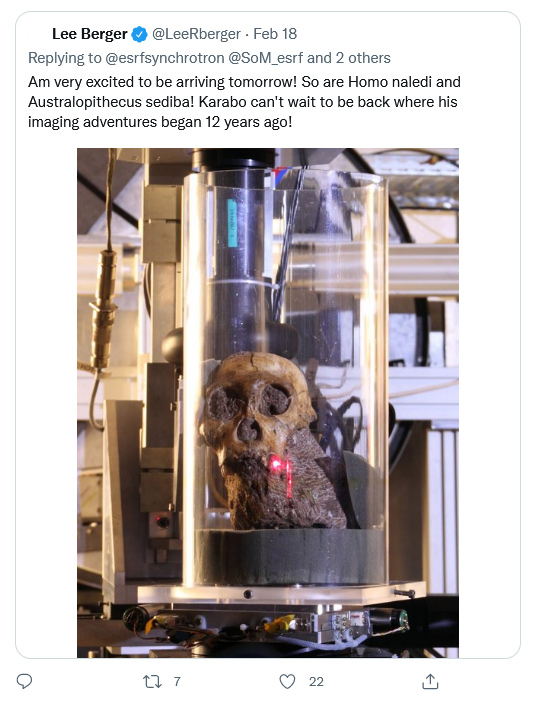- Home
- News
- General News
- Australopithecus...
Australopithecus sediba is back at the ESRF – and this time he’s not alone!
23-02-2022
The famous fossil of Australopithecus sediba is back at the ESRF – the European Synchrotron in Grenoble, France – 12 years after first being scanned by its powerful X-rays. But this time he is not alone. Palaeoanthropologist Lee Berger also brings precious fossils from Homo naledi, a new species of human relative, whose discovery has changed the way scientists think about human origins.
Lee Berger’s explorations have resulted in the discovery of more individual fossil hominin remains than any other exploration programme in the history of the search for human origins in Africa. Among Berger’s many notable finds are the discoveries of two new species of ancient human relatives: Australopithecus sediba, a fossil discovered in 2008 that shows an intriguing mix of apelike and humanlike characteristics; and Homo naledi, found in 2013 amid the richest early hominin site yet found in Africa.
In 2010, the first synchrotron X-ray images of the two-million-year-old Australopithecus sediba fossils from the Malapa site in South Africa were taken at the ESRF. The resulting data, along with that from subsequent scanning efforts, have been used in a large number of scientific and popular publications, and have resulted in significant breakthroughs in understanding the origins of humanity.
Today, 12 years later, Lee Berger has teamed up once again with ESRF palaeontologist Paul Tafforeau to use the world's brightest synchrotron – the ESRF Extremely Brilliant Source (EBS) – and its new BM18 beamline for X-ray microtomography. Set to open in September 2022, BM18 will enable scientists to study big fossils in 3D at the microscale without damaging them.
The team of scientists started to scan premolars of A. sediba all day and night on Saturday and Sunday. They aim to establish the exact age of death of A. sediba by visualising disruptions in incremental growth lines in the teeth. But that’s not all. The team will continue this exceptional week of experiments by scanning the extraordinary specimen of a Homo naledi child’s skeleton and potentially other objects embedded in a large block of rock. Using the ESRF’s high-resolution X-ray techniques for the first time to image this fossil, Lee Berger and the team hope to uncover some of the many exciting mysteries still surrounding this intriguing ancient human relative.
 |
 |
 |
Above: Tweets from Lee Berger and the French Ambassador to South Africa show the excitement surrounding the experiments.
“It’s hard to put into words how excited I am to see the results of these specimens in front of this incredible machine,” said Lee Berger. “Here at the ESRF, the most powerful X-rays and the longest beamline in the world has been designed especially to do these unprecedented experiments – this is the only instrument in the world that can do this. This should allow us to answer some of the important questions about the life and death of the individual fossil but also of the whole species itself. I’ve yet to see the magic that the Extremely Brilliant Source is going to reveal inside the rocks but I can’t wait!”
Top image: Paleoanthropologist Lee Berger scans two-million-year-old ancient human fossils at new ESRF beamline BM18. Photo: P. Jayet/ESRF.



